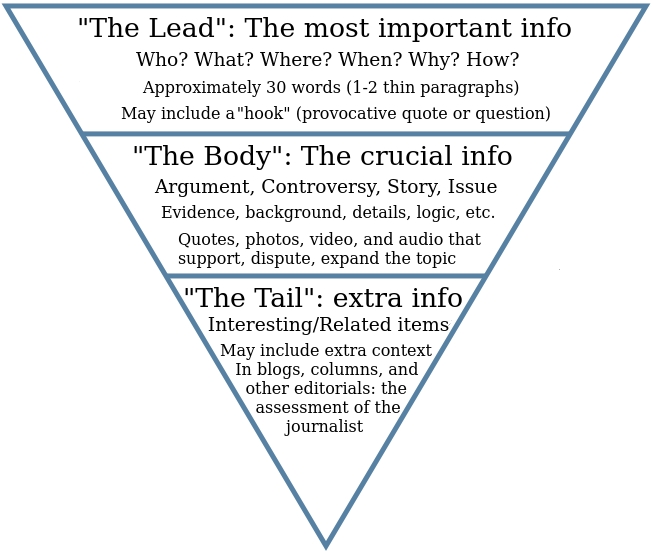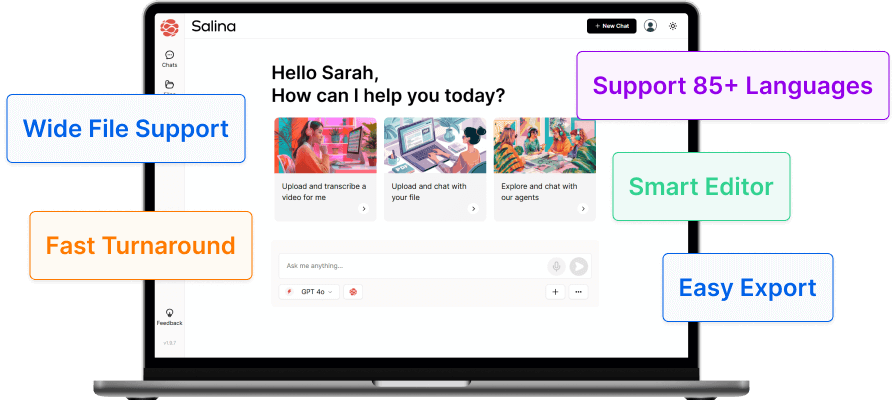Here are eight ways to organize information, ensuring your content connects with your readers. Learn how to structure your ideas to make sure your writing is made clear and impactful.
I have always appreciated exploring art exhibits and museums while traveling solo, but when it comes to local visits, I prefer the company of my best friend, Anna. It had been some time since our last museum visit when she unexpectedly invited me to an exhibition last week—her own, after graduating from art school. I felt incredibly proud and eagerly anticipated continuing our shared tradition.
At the exhibition, I was captivated by the evolution of her art, portraying a journey from the purity of birth to the stark truth of our mortality. Beyond the art itself, navigating through the exhibit unveiled the careful curation she dedicated to crafting the whole encounter. Every artwork found its precise spot, enriching a coherent and captivating narrative.
As a writer by profession, the experience for me highlighted the significance of structure in writing. Like a well-organized exhibit, compelling content must be coherent, captivating, and follow a logical progression. A weak structure risks losing your message, leading to audience confusion and disinterest.
This blog will explore exactly that, the structure in writing or more specifically the effective ways of organizing information for crafting impactful written content.
8 Ways to Organize Information in Your Writing
Before we jump into the eight ways, it’s essential to understand why structuring information matters. Just as a building needs a strong structural design to be durable, your writing needs a framework to support your ideas and ensure they are effectively communicated.
In reaction to the daily deluge of information we encounter, our brains have evolved to skim content, naturally looking for patterns and coherent structures. The absence of these components in your writing could result in lackluster responses from readers who may feel puzzled, disengaged, or dismissive.
Without further delay, here are eight ways to structure and organize information in your content writing:
1. Guide Readers Through Your Argument
In content writing, there’s a method to the madness. When organizing your information, think about the logic of your argument. Start with the most crucial details first, then follow up with supporting information in descending order of importance. By using the inverted pyramid approach from journalism, you’ll hook readers with key points upfront and then provide the full story later on.
For example, an article about climate change starts by highlighting recent impactful events, drawing readers in. It then explores root causes, organizing details from most to least important for reader interest.
An image that best represents this comes from The Ohio State University Pressbooks. Emphasizing the importance of starting with the 5 W’s and 1 H as “The Lead”, then moving forward to “The Body” which is the most crucial piece of information. Lastly, “The Tail” leaves room for interesting facts and additional information.

Types of written content this works best for:
- News Articles
- Press Releases
- Blog Posts
- Executive Summaries
2. Make Use of Chronology in your Storytelling
Telling a story or explaining a process in chronological order can deeply resonate with readers, evoking emotions and enhancing their comprehension by presenting events as they unfold. This approach is mostly used in expository writing, wherein readers are guided through a sequence of events and occurrences.
For instance, an article about the history of technology might start with its invention and then jump to its latest innovations, with key events in the middle presenting a coherent narrative.
Types of written content this works best for:
- Historical accounts or biographies
- Tutorials or how-to guides
- Personal narratives or memoirs
- Case studies or project reports
3. Place Importance to Space and Setting
Organizing content based on location or the physical arrangement of elements is called the spatial order. This method is particularly useful for descriptive pieces, where setting the scene is crucial. By guiding the reader through the environment, you create a vivid mental picture, enhancing their understanding and engagement.
For example, when writing about a travel destination, you can begin with the entrance, cover the main attractions in order, and end with the exit or final point of interest. This method helps readers easily follow and imagine the journey as if they were present.
While targeted at educators, this LinkedIn article explores using images to improve understanding. It discusses how to apply and refine this method, highlighting the importance of visuals in comprehension. Even if we’re not conventional teachers, as writers, our duty is to provide valuable data and information to our readers. Highlighting the importance of this particular resource.
Types of written content this works best for:
- Descriptive essays
- Travel guides
- Real estate listings
- Architectural reviews
4. Engage with a Compelling Climax
Climactic order arranges information so that the most important or impactful point comes last. This method is ideal for persuasive writing, opinion pieces, or any content where you aim to leave a strong impression on your audience. By strategically placing the most compelling information or argument at the end, you ensure it remains fresh in the reader’s mind, potentially swaying their perspective.
For instance, in a persuasive article about environmental conservation, you might start with general facts about pollution, followed by impacts on wildlife, and culminate with the most dramatic effect on human health, thereby emphasizing the urgency of the issue.
Types of written content this works best for:
- Persuasive essays
- Speeches
- Sales presentations
- Argumentative articles
5. Categorize through Topics
Breaking down a topic into subtopics or categories to simplify complex information is referred to as the topical order in writing. This approach, commonly used in speeches, is effective for broad or complex subjects. Organizing information in this way enhances the comprehension of relationships and differences between ideas. Each section or paragraph can focus on a specific aspect, theme, or category, helping readers understand the subject comprehensively without being overwhelmed.
For example, an article on renewable energy might be divided into sections such as solar, wind, hydroelectric, and biomass, each exploring the specific technologies, benefits, and challenges associated with these energy sources. This method not only structures content logically but also facilitates navigation and comprehension.
DK is a creative producer and speaking coach and in this video, he effectively demonstrated how to utilize a topical order when crafting his speech.
His TEDx presentation dissects exceptional public speaking into three fundamental components, along with a nifty technique to soothe nerves. Leveraging insights gained from spearheading TEDxWellington and mentoring speakers, DK simplifies the process for audiences. Empowering individuals to deliver memorable speeches that resonate.
Types of written content this works best for:
- Speeches
- Academic research papers
- Business reports
- Thematic essays
6. Emphasize with Emotional Impact
Writing that focuses on prioritizing information based on its emotional impact or importance rather than its chronological or logical sequence is known as the emphatic order. This approach highlights the most crucial details in positions that will have the greatest impact on the reader, often at the beginning or end of the content. Emphatic order works well in narrative writing, personal essays, or speeches where capturing and holding the reader’s attention is key.
For instance, in a piece advocating for social change, you could start with a compelling personal story to immediately connect with the reader emotionally, present statistics and arguments to support your points, and finish with a call to action that mirrors the emotional intensity of the opening.
Types of written content this works best for:
- Personal essays
- Narrative stories
- Persuasive speeches
- Advocacy articles
7. Persuade by Presenting a Problem and a Solution
Organizing content by presenting a problem first and then a detailed solution later is a method proven to be effective in persuasive writing, policy papers, business proposals, or any content that aims to inspire action. By starting with a clear description of the problem, you grab the reader’s attention, showing them why the issue is important. Then, explaining the solution(s) lays out a clear path forward, encouraging deeper engagement with your content.
For instance, a report on the declining bee population may begin by emphasizing their alarming disappearance rate. It can then suggest solutions such as habitat restoration and pesticide regulation, smoothly transitioning from issue to action.
Types of written content this works best for:
- Business proposals
- Policy papers
- Persuasive essays
- Problem-solving articles
8. Contextualize by Comparing and Contrasting
Highlighting the similarities and differences between subjects is ideal for analytical pieces or reviews. A comparative structure such as this enables readers to critically evaluate each subject’s characteristics, benefits, and drawbacks through direct comparison. Giving a deeper understanding of two or more subjects in a more meaningful way.
For example, in comparing two software tools, you could contrast their features, usability, pricing, and support, helping readers make informed decisions. This method fosters critical thinking and simplifies complex information.
Types of written content this works best for:
- Product reviews
- Comparative essays
- Market analysis reports
- Literary analysis
How AI Can Assist Content Writers in Organizing Information:
AI is increasingly used in content writing, offering tools to enhance content organization. It evaluates readability, recommends headings, automates lists, and adjusts sentence length for reader engagement. This allows writers to concentrate on their main message effectively.
AI Writing Tools for Content Writing:
AI-powered writing tools are essential for simplifying content creation, especially when dealing with complex information. Noteworthy tools include:
Chatbots that leverage natural language processing, these tools offer personalized writing assistance, generate content on demand, and provide insights based on the user’s specific needs.
Copilot
Uses Microsoft’s latest AI technologies, offering users the ability to engage in conversational searches, receive detailed responses, and even get assistance with content creation, making it a versatile tool for research and writing tasks.
Gemini
A cutting-edge chatbot designed for a range of content creation tasks. It specializes in generating and suggesting content ideas, writing drafts, and offering revisions, thereby acting as a virtual writing assistant that enhances productivity and creativity.
ChatGPT
An extension of the OpenAI family, ChatGPT excels in using deep learning to create text responses resembling human writing. It’s great for articles, essays, code snippets, and more, adjusting to different styles and formats. This makes ChatGPT a vital tool for writers aiming for efficient and versatile content creation.
AI content generators that can curate content based on keywords and themes, offering writers a starting point or an alternative viewpoint.
Copy.ai
Copy.ai is favored for creating diverse marketing content, including social media posts, blog ideas, and product descriptions, with a user-friendly interface for simple keyword inputs.
Jasper
Highly effective in swiftly generating high-quality content, Jasper caters to various content types such as blog posts, emails, ad copy, and social media content, making it a versatile tool for creators.
AI-powered writing editors that scan for issues such as passive voice, unclear antecedents, and sentence length, in real-time.
Grammarly
Best-known AI writing assistant. Checks beyond spelling and grammar, suggesting improvements for clarity, engagement, and delivery. Advanced features: detects passive voice, offers synonyms for clarity, and analyzes sentence lengths for better readability.
Hemingway Editor
Simple yet effective in enhancing writing clarity. Highlights complex sentences and errors that hinder readability, like passive voice. Offers simpler alternatives to enhance readability, favored by writers aiming for clear, bold writing.
ProWritingAid
A comprehensive tool for grammar, style editing, and writing coaching. Identifies various issues like passive voice overuse, unclear antecedents, and sentence length variation. Detailed reports offer insights into writing style, aiding users in skill enhancement.
Knowledge management systems that use AI to categorize and tag content, making it easier for writers to find, reference, and structure their data.
Zettlr
A markdown editor aiding writers in efficient research and writing management. While not a full knowledge management system, its AI-powered search and tagging features assist in organizing notes, references, and ideas.
Obsidian
A robust note-taking and knowledge management tool using Markdown formatting. It offers bidirectional linking, a graph view, and AI-driven search to organize notes, ideas, and references effectively.
Roam Research
Introduces a “networked thought” approach for organizing ideas and research. With bidirectional linking, block-level referencing, and AI-driven graph view, it simplifies discovering connections between information.
Summarization tools that use AI to condense lengthy articles, saving time and ensuring the crux of the article is delivered to the reader.
QuillBot
Quillbot has a summarization tool that utilizes AI to create brief summaries of articles and documents. It uses sophisticated algorithms to pinpoint key details and shorten the text, aiding writers in saving time and emphasizing the content’s core message.
Brevity
An AI tool that summarizes lengthy articles and documents by extracting main points. It uses advanced algorithms to analyze and generate easy-to-read summaries, perfect for writers needing quick content insights.
Key Takeaways
- Structuring and organizing information in content writing combines discipline and creativity.
- The aim is to create content that is both logically sound and emotionally engaging for readers.
- Effective content structuring can make the difference between a memorable article and one that fades into obscurity.
- Incorporating the ten ways mentioned can significantly enhance your writing process.
- AI is a valuable tool for improving content structuring and making complex data more understandable and engaging.
- Use these tools and tips to craft writing that withstands scrutiny and the test of time.
What’s Next
Remember, the art and science of effective content writing are not fixed. It evolves with technology, audience needs, and writing trends. Stay updated and adapt these practices to suit your style and the goals of your writing. After all, the most successful content is crafted not for the writer, but for the reader.




